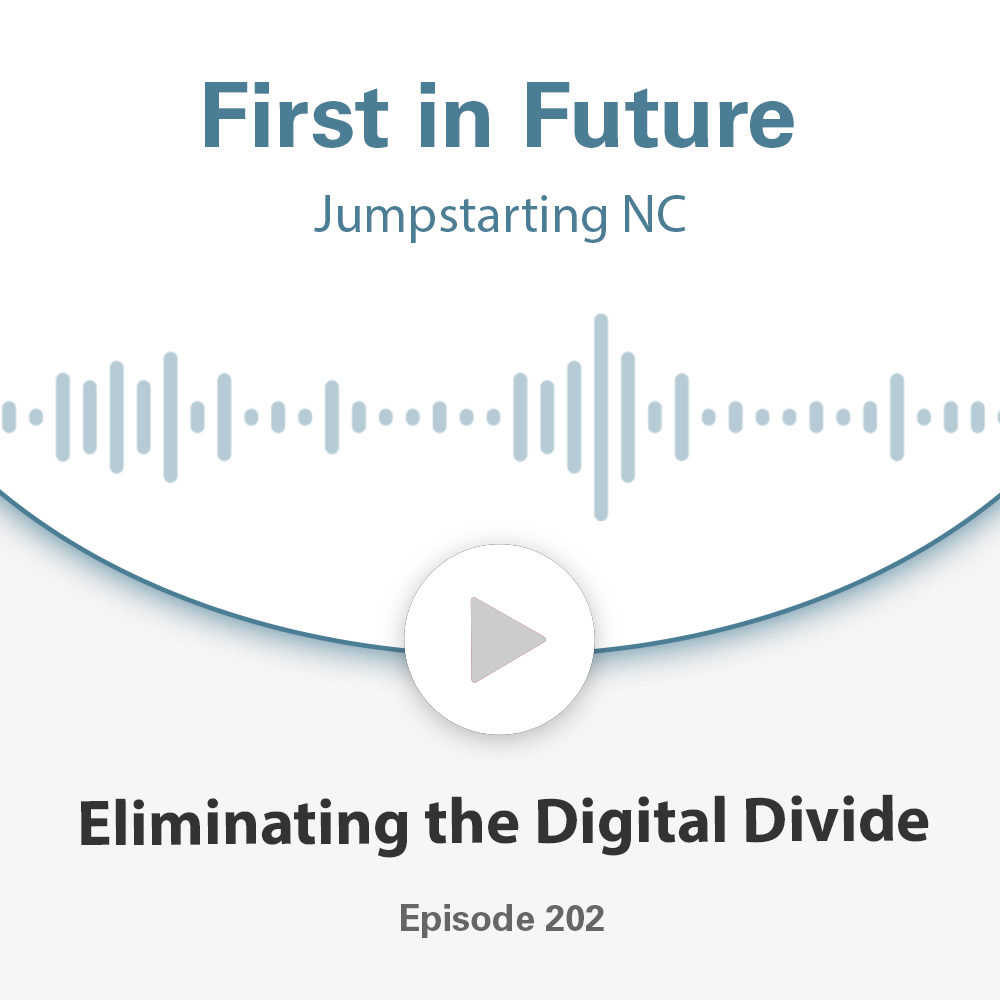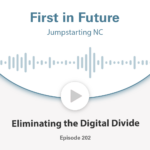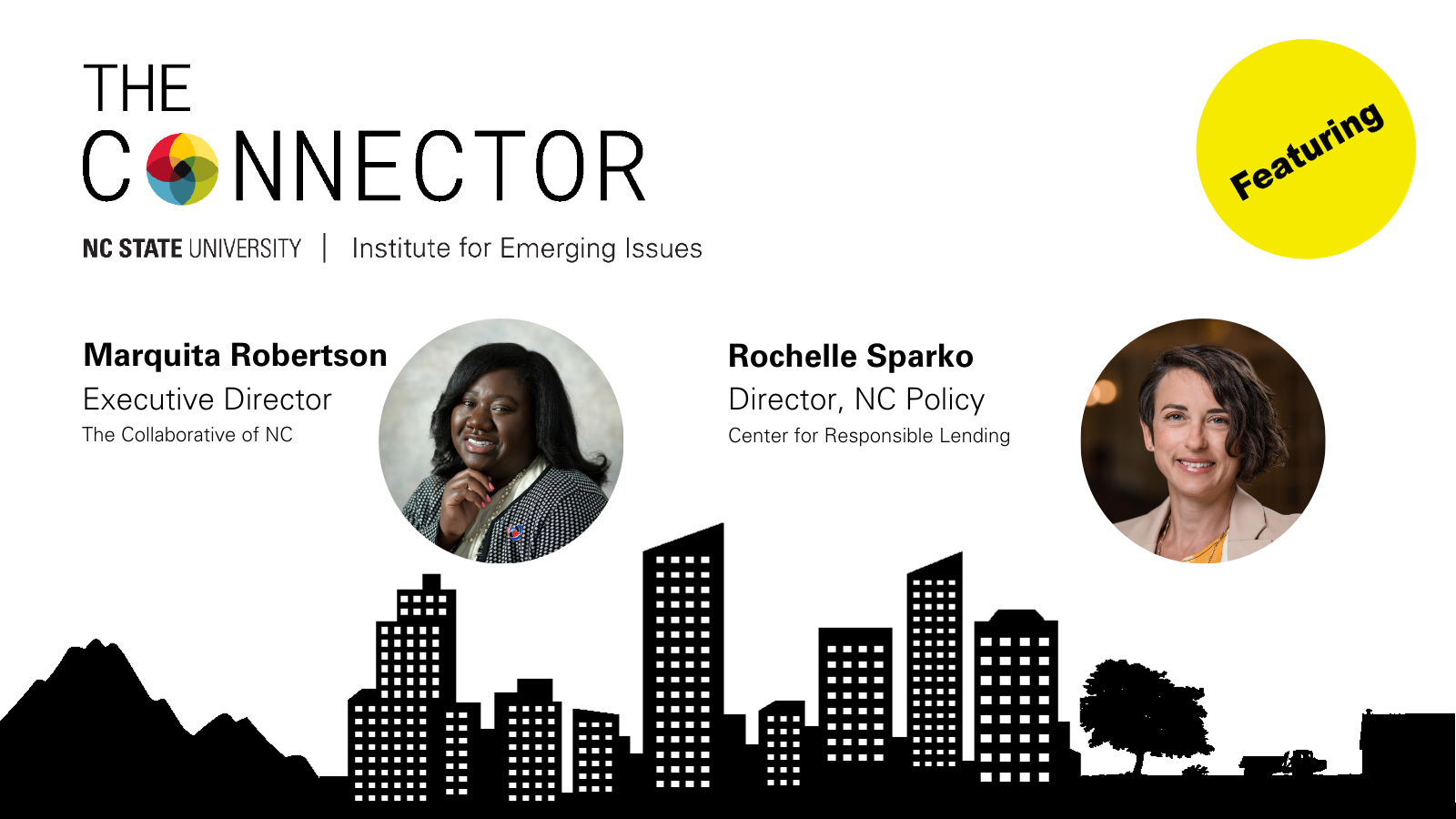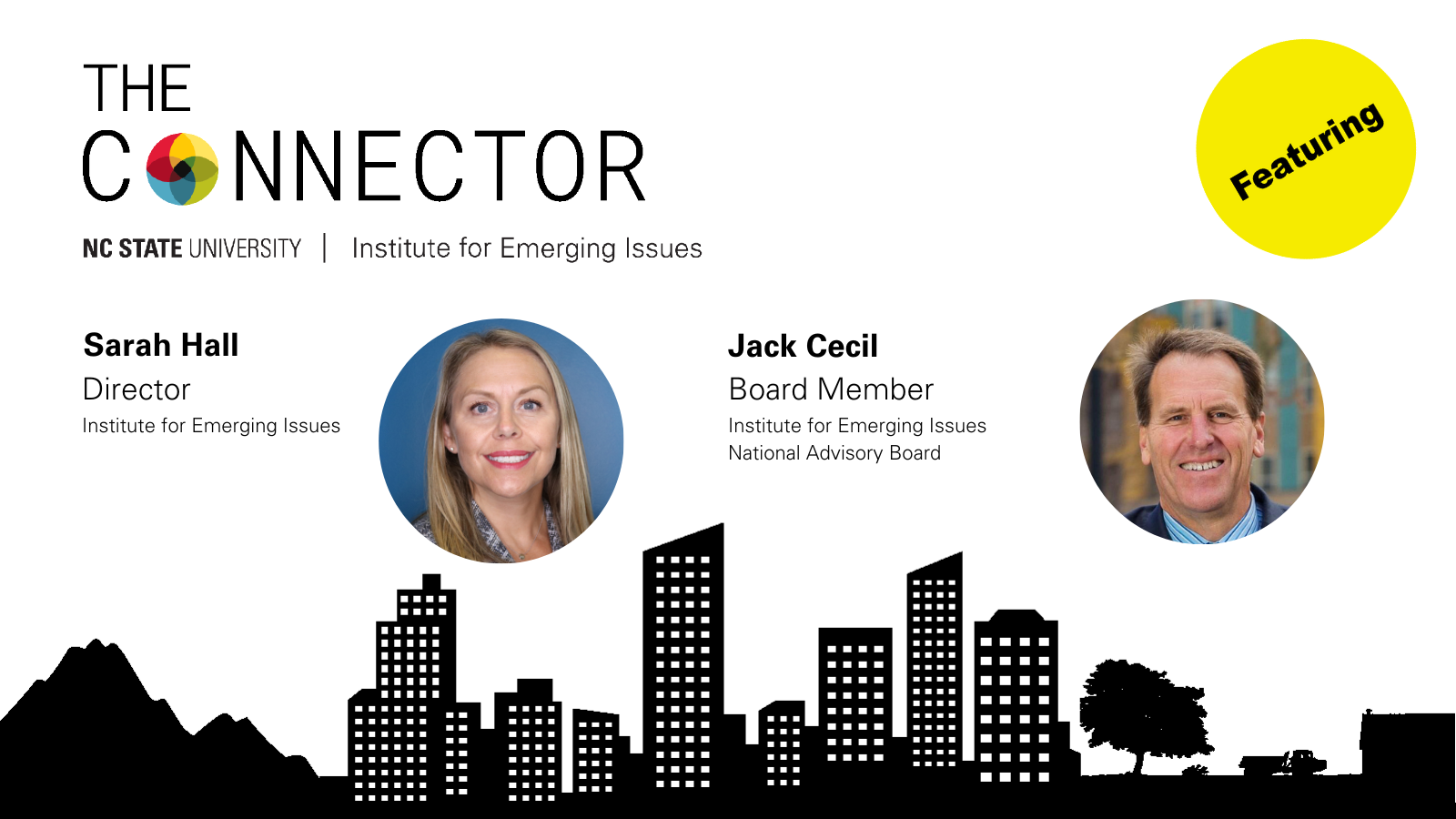Jumpstart Connectivity- Eliminating The Digital Divide

 Summary: Join us for this episode, Jumpstart Connectivity: Eliminating the Digital Divide in North Carolina’s Cities and Towns.
Summary: Join us for this episode, Jumpstart Connectivity: Eliminating the Digital Divide in North Carolina’s Cities and Towns.
How cities and towns across the state are addressing the digital divide and emerging from the pandemic with key strategies to increase digital access and skills.
Join guest host Maggie Woods (IEI Policy and Program Manager) and guests Veronica Creech (City of Raleigh), Seth Ervin (Charlotte Mecklenburg Library), Michael Abensour (Kramden Institute) and Sherrell Dorsey (BLKTECHCLT).
*This episode of First in Future was recorded on Thursday, June 25th, and reflects information that was up-to-date at that time.*
View the slides here.
Listen to the podcast or Watch Zoom Video
- In a pandemic, the internet is a lifeline. Without it, you can’t do homework, work from home, apply for unemployment, or access your doctor or your bank.
- Based on what is considered flawed data from FCC, almost 95% of North Carolinians have access to the internet.
- About 22% of North Carolinians are subscribed to internet and 40% aren’t subscribed to high speed internet. About 25% don’t have access to a desktop or laptop – about 9% only access the internet through a smart phone. Disparities by economic status and race and ethnicity
- The number of people in urban households don’t have internet access because they’re can’t afford it is 4x the number of rural Americans who don’t have access
What does digital inclusion mean? How is the Charlotte Mecklenburg Library System working on it?
Seth Ervin: Three legged stool – access to the internet, devices, and education opportunities. In the pre-COVID world, CMLS offered free wifi, access to computers and technology classes.
What does the Kramden Institute do and what was your pandemic response?
Michael Abensour: Refurbish computers and give them out in the community – approximately 40,000 across NC. Digital literacy classes, after school programs. Once the pandemic hit, put out a Facebook post offering a computer to anyone who needed it and received 5,000-7,000 calls over the next few days. Trying to give away as many computers as possible while keeping staff and recipients safe.
What does Black Tech Charlotte do and how has the work shifted since the pandemic?
Sherrell Dorsey: Built the initiative around gathering, community and training for Black technologists. Had to change the way we deliver services to community. Offer online learning now, but trying to recreate that experience online has been challenging.
The digital divide has been an ongoing conversation for years, especially considering that Black people and those from the Latinx community will be disproportionately disadvantaged. It’s been frustrating that we’ve been trying to forewarn leaders for years and now we’re trying to scramble to support families so they can go to school and work.
What’s the relationship between digital inclusion and economic development?
Veronica Creech: Digital inclusion is part of not just economic development, but equitable economic development. Leadership in Raleigh has had closing the digital divide in the city strategic plan for the last three years.
What does the digital divide look like in Raleigh?
Veronica Creech: The FCC data is not an accurate representation of household access. It’s beyond misleading – it’s almost criminal. It doesn’t help leaders understand the depth of the problem. We recently did an assessment of city facilities (community centers, etc.) and found that many are not wifi-capable. Kids are having to go to other places to get spillover wifi. In the pandemic, we’re seeing how many kids aren’t connected. It takes time to understand the depth and breadth of numbers. If kids today aren’t getting fully connected, deficits will start showing up in employment, college applications, etc.
From Raleigh’s perspective, why does it matter for rural connectivity to be a priority too?
Veronica Creech: We need everyone connected. Our talent, workforce, educators commute in from rural communities. We want all communities to be connected to have competitive skill sets and tools. “Internet at home is as critical as having utilities in the home.” Leadership needs to internalize that.
Strategies to make sure that public housing has access?
Veronica Creech: When a city or county provides funding, that’s the perfect opportunity to require a built-in wifi solution. We need internet and wifi connectivity to be considered a utility so that can be built in.
Strategies that Raleigh is developing to close the digital divide?
Veronica Creech: Digital Connectors program; closing digital divide in strategic plan; cross-departmental approach; Smart Cities initiative; NC Digital Equity Team.
How has CMLS been able/not able to address digital inclusion after closing?
Seth Ervin: CMLS was able to transition a lot of what we do to our digital platform – reference desk, programming. But there’s no way to provide internet access. “The public library can only do so much. This is systemic. It is tied to morality and justice.” COVID has highlighted that we don’t have a way to provide access outside of brick and mortar offerings. Wifi is on 24/7 so people can at least go into the parking lot and access. Outfitting career vans with mobile solutions. Trying to shift to proactivity and sound the alarm that this is important.
What is Charlotte Digital Inclusion Alliance and what is it trying to do?
Seth Ervin: Alliance of institutions, government, universities working to follow digital inclusion best practices. Trying to look at systemic solutions to these problems and think broader than our focus areas.
What does the digital divide in Charlotte look like?
Seth Ervin: Follows an unsurprising pattern. 2015 Chetty study showed that a kid born in poverty would probably stay in poverty. Digital inclusion/digital adoption follows that same pattern – by race and socioeconomic class. Library and some CDIA partners are going for an IMLS CARES grant to work towards a systemic solution in one census tract in the West Boulevard corridor where 70% doesn’t have broadband.
Who are catalysts in the community?
Sherrell Dorsey: Don’t have enough narrative or study on what Black and brown innovation looks like in this country. If we’re not collecting data, we won’t know who’s getting resources. Black Tech Charlotte collected a list of more than 2,000 Black technologists and founders over four years. If they had the right resources, they could grow exponentially and creating jobs. They want to invest in their community and pass on STEM skills and training. But because of systemic challenges, lack of funding and visibility, we don’t get to see that kind of growth happen. Even for people with access, if they can’t get support to become leaders, then we’re still perpetuating the challenges.
Partnership with Flatiron School to help reskill?
Sherrell Dorsey: Self-paced classes in fields like cybersecurity, software engineering. People who were reaching out about training opportunities can’t take time off to go back to school. This offers more flexibility. There are also training camps for young people to learn these skills in middle and high school, college.
How is Kramden Institute supporting English language learners, seniors, other groups?
Michael Abensour: Our digital literacy programs are constantly evolving based on what people need and want. Open to anyone in the community who wants to come – at Kramden, in public housing, at partner organizations. In Spanish, in senior communities, in after school programs. At the end of four classes, they get a free computer. Average of 1,500-2,000 people per year, but because of COVID, you can’t move basic digital literacy classes online. Kramden is pausing, but when it comes back the need will probably be double.
- Categories:


